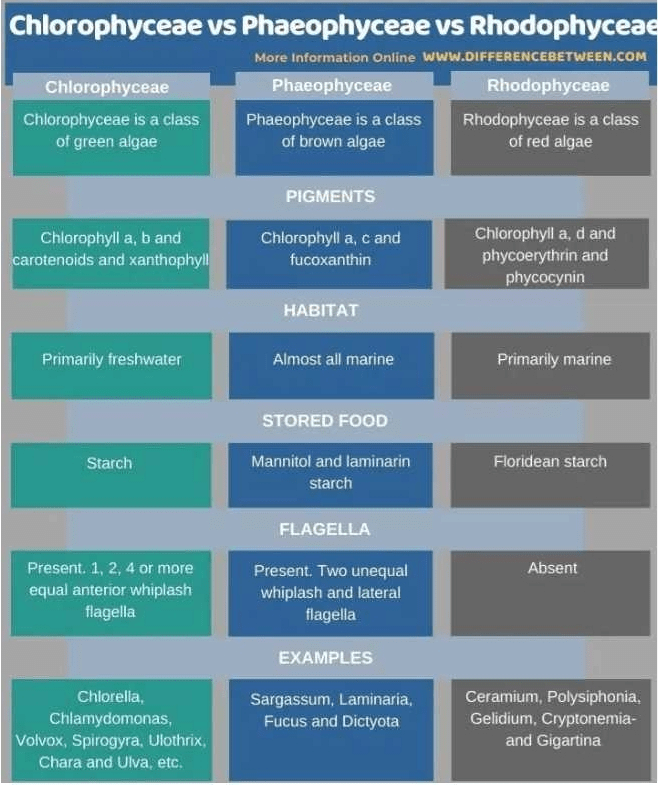NEET Exam > NEET Questions > Brief differentiation between CHLOROPHYCEAE ,...
Start Learning for Free
Brief differentiation between CHLOROPHYCEAE , PHAEOPHYCEAE & RHODOPHYCEAE .?
Most Upvoted Answer
Brief differentiation between CHLOROPHYCEAE , PHAEOPHYCEAE & RHODOPHYC...

Community Answer
Brief differentiation between CHLOROPHYCEAE , PHAEOPHYCEAE & RHODOPHYC...
Chlorophyceae and Phaeophyceae are two classes of algae that belong to the division Chlorophyta. The main differences between these two classes are as follows:
1. Pigmentation: Chlorophyceae are green algae, which means they contain chlorophyll a and b, as well as carotenoids and xanthophylls. Phaeophyceae are brown algae, which means they contain chlorophyll a and c, fucoxanthin, and other carotenoids.
2. Habitat: Chlorophyceae are mainly freshwater algae, although some species can also be found in marine or terrestrial habitats. Phaeophyceae are primarily marine algae, although some species can also grow in brackish water.
3. Cell structure: Chlorophyceae have a unicellular or multicellular structure, with a single chloroplast per cell. Phaeophyceae are multicellular, with complex thallus structures that can be differentiated into different tissues.
4. Reproduction: Chlorophyceae reproduce asexually by means of cell division or fragmentation, or sexually by means of isogamy, anisogamy, or oogamy. Phaeophyceae reproduce asexually by means of fragmentation or spores, or sexually by means of isogamy or oogamy.
5. Economic importance: Chlorophyceae are used in aquaculture as a source of food for fish and other aquatic organisms, as well as in biotechnology for the production of biofuels and pharmaceuticals. Phaeophyceae are also used in aquaculture as a source of food, as well as in the food industry for the production of alginates, which are used as thickeners and stabilizers in food products.
1. Pigmentation: Chlorophyceae are green algae, which means they contain chlorophyll a and b, as well as carotenoids and xanthophylls. Phaeophyceae are brown algae, which means they contain chlorophyll a and c, fucoxanthin, and other carotenoids.
2. Habitat: Chlorophyceae are mainly freshwater algae, although some species can also be found in marine or terrestrial habitats. Phaeophyceae are primarily marine algae, although some species can also grow in brackish water.
3. Cell structure: Chlorophyceae have a unicellular or multicellular structure, with a single chloroplast per cell. Phaeophyceae are multicellular, with complex thallus structures that can be differentiated into different tissues.
4. Reproduction: Chlorophyceae reproduce asexually by means of cell division or fragmentation, or sexually by means of isogamy, anisogamy, or oogamy. Phaeophyceae reproduce asexually by means of fragmentation or spores, or sexually by means of isogamy or oogamy.
5. Economic importance: Chlorophyceae are used in aquaculture as a source of food for fish and other aquatic organisms, as well as in biotechnology for the production of biofuels and pharmaceuticals. Phaeophyceae are also used in aquaculture as a source of food, as well as in the food industry for the production of alginates, which are used as thickeners and stabilizers in food products.

|
Explore Courses for NEET exam
|

|
Question Description
Brief differentiation between CHLOROPHYCEAE , PHAEOPHYCEAE & RHODOPHYCEAE .? for NEET 2025 is part of NEET preparation. The Question and answers have been prepared according to the NEET exam syllabus. Information about Brief differentiation between CHLOROPHYCEAE , PHAEOPHYCEAE & RHODOPHYCEAE .? covers all topics & solutions for NEET 2025 Exam. Find important definitions, questions, meanings, examples, exercises and tests below for Brief differentiation between CHLOROPHYCEAE , PHAEOPHYCEAE & RHODOPHYCEAE .?.
Brief differentiation between CHLOROPHYCEAE , PHAEOPHYCEAE & RHODOPHYCEAE .? for NEET 2025 is part of NEET preparation. The Question and answers have been prepared according to the NEET exam syllabus. Information about Brief differentiation between CHLOROPHYCEAE , PHAEOPHYCEAE & RHODOPHYCEAE .? covers all topics & solutions for NEET 2025 Exam. Find important definitions, questions, meanings, examples, exercises and tests below for Brief differentiation between CHLOROPHYCEAE , PHAEOPHYCEAE & RHODOPHYCEAE .?.
Solutions for Brief differentiation between CHLOROPHYCEAE , PHAEOPHYCEAE & RHODOPHYCEAE .? in English & in Hindi are available as part of our courses for NEET.
Download more important topics, notes, lectures and mock test series for NEET Exam by signing up for free.
Here you can find the meaning of Brief differentiation between CHLOROPHYCEAE , PHAEOPHYCEAE & RHODOPHYCEAE .? defined & explained in the simplest way possible. Besides giving the explanation of
Brief differentiation between CHLOROPHYCEAE , PHAEOPHYCEAE & RHODOPHYCEAE .?, a detailed solution for Brief differentiation between CHLOROPHYCEAE , PHAEOPHYCEAE & RHODOPHYCEAE .? has been provided alongside types of Brief differentiation between CHLOROPHYCEAE , PHAEOPHYCEAE & RHODOPHYCEAE .? theory, EduRev gives you an
ample number of questions to practice Brief differentiation between CHLOROPHYCEAE , PHAEOPHYCEAE & RHODOPHYCEAE .? tests, examples and also practice NEET tests.

|
Explore Courses for NEET exam
|

|
Signup for Free!
Signup to see your scores go up within 7 days! Learn & Practice with 1000+ FREE Notes, Videos & Tests.























